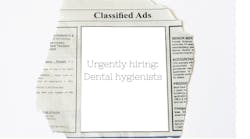Dental hygiene staffing apps: Tips to find that perfect temp position
According to November 2023 data from the ADA Health Policy Institute, approximately one third of dentists are actively recruiting to fill dental hygienist positions, and nearly 95% find it “very” or “extremely difficult” to recruit.1
Enter the booming temp economy. If you’ve ever considered temping, now is the perfect time to look into it. High demand and short supply have led to an abundance of well-paid temporary hygienist jobs. The best place to find those jobs? Dental staffing applications. Here are some valuable lessons I’ve learned while finding temping positions via staffing apps.
Finding work assignments
Sign up for as many staffing apps as you can. Do an internet search for your state and ask other hygienists what apps they’re using. Create a basic profile and monitor the apps daily for posted shifts. If listing your availability is required, update it on a weekly basis.
Be proactive and contact offices in your area to introduce yourself so they’ll think of you next time they need a temp. Most apps allow ads for permanent placement. Check if there are any practices near you that are hiring and offer to fill in while they search for the right fit.
How is pay determined?
On some apps you post your hourly rate and offices automatically agree to that rate when they book you. Other apps ask that the office post the rate they offer for a specific shift. In this case, know that you can counter the offer using either a special button in the app or the messaging system.
Some apps pay you via direct deposit, while others have the dental practice pay you on the day of your shift. Depending on the app, taxes may or may not be withheld from your pay. Check the laws in your state regarding temp dental hygienists as contractors versus employees. If you’re responsible for filing your own taxes (contractor), be sure you talk to your accountant about possible deductions, such as loupes, supplies, continuing education courses, uniforms, and mileage.
What are the benefits?
If you’re considered a contractor, you likely won’t receive benefits. On the other hand, if you’re an employee, you may be entitled to benefits such as health insurance and vacation pay if you work a minimum number of hours per month. How you’re classified varies by app. In case benefits are not provided, you must secure a health care plan, get disability and liability insurance, open a retirement account, save for vacation, and purchase uniforms and possibly equipment.
Fortunately, many of these expenses are tax deductible. Some of the well-established apps provide free continuing education courses for members. Make sure you’re keeping track of licensing requirements, CPR, and other certification renewals.
Before you accept a shift
Most apps have the practice name listed along with the shift details. Take advantage of this and do a quick internet search to get an idea of the office and staff. You can look for images of the operatories to see what kind of equipment is available. Double check the commute distance as the apps are often not accurate. Find out if you’ll be working more than one column and how long each patient/procedure is on the schedule. Check whether there is a lunch break and how long. Ask about parking and if there’s a parking fee.
Good work practices
Be early: Arrive at least 15 minutes before the first patient. I like to arrive 30 minutes beforehand. Leave yourself extra time for traffic, issues finding the office, parking, elevator rides, and so on.
Be presentable: Wear clean and pressed scrubs that are in good condition. Have a neat hair style, minimal makeup, and clean nails. In short, look professional.
Be a team player: One thing that will set you apart is doing things that are not required. Help with sterilizing instruments, scheduling the next visit, entering treatment, or taking the trash out at the end of the day. If you have a cancellation, make yourself useful and see if anyone needs help.
Treat patients as your own: Treat patients the way you would if you were a full-time hygienist at the practice. Take ownership of the situation and provide the best care you can. If patients compliment you in front of the doctor, you will definitely be invited back.
What to take to a temp job
Loupes: There are offices with no overhead lights. Bring an extra battery even if one is supposed to last all day. You don’t want the stress of something going wrong, in addition to the stress of being in a new environment.
Time sheet: Bring a timesheet and make a point of giving your correct hours to the person responsible for paying you. Avoid accepting a check that has only the hours you spent treating patients. If you came in early, stayed late, or worked through lunch, be sure to indicate that.
Lab coat: Not every office has extra lab coats and if they do, they might be the disposable kind. Bring your own. I prefer the textile reusable kind that looks very neat and professional.
Water and snacks: Bring water for the whole day. You may not have time to buy water, and the office may not provide bottled water or a cooler. If there is no lunch break, it’s a good idea to have a small snack to eat between patients.
Whether you’re a new graduate wanting to experience different types of practices, or a seasoned hygienist who wants to add an extra day to your workweek, there are plenty of temping opportunities for everyone. I hope you now feel equipped with the right tips to make the most of them.
Reference
1. Economic outlook and emerging issues in dentistry. Insights from data from November 2023. ADA Health Policy Institute.
Anastassia Stoenelova, BA, RDH, has been in dentistry for 10 years. She currently practices clinically in Atlanta, Georgia. As a former ESL instructor, she's passionate about oral health education and making a difference in her patients' lives. She works with Second Wind Dreams, a nonprofit organization that educates health-care professionals about dementia, and she is a recruiter for CUSP dental app. Contact her at [email protected].









